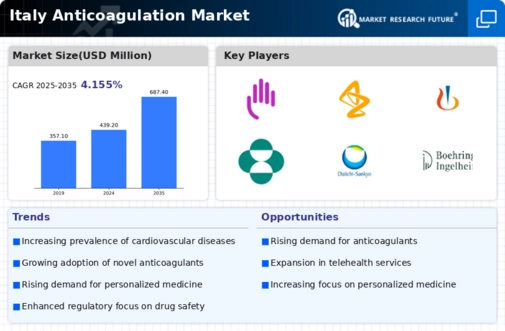Enhanced Awareness of Thrombosis Risks
The heightened awareness of thrombosis risks among the Italian population is influencing the anticoagulation market. Public health campaigns and educational initiatives have successfully informed individuals about the dangers of blood clots and the importance of anticoagulation therapy. As a result, more patients are seeking medical advice and treatment options for thromboembolic conditions. This increased awareness is reflected in the rising number of prescriptions for anticoagulants, which have reportedly increased by 15% over the past year. Healthcare providers are also more proactive in screening at-risk populations, further driving demand for anticoagulant therapies. The collaboration between healthcare professionals and patient advocacy groups is likely to continue fostering this awareness, thereby contributing to the growth of the anticoagulation market. Overall, the enhanced awareness of thrombosis risks is a key factor propelling market dynamics in Italy.
Rising Incidence of Cardiovascular Diseases
The increasing prevalence of cardiovascular diseases in Italy is a primary driver for the anticoagulation market. According to recent health statistics, cardiovascular diseases account for approximately 35% of all deaths in the country. This alarming trend necessitates effective anticoagulation therapies to manage conditions such as atrial fibrillation and venous thromboembolism. As the population ages, the demand for anticoagulants is expected to rise significantly. The Italian healthcare system is likely to allocate more resources towards anticoagulation treatments, thereby expanding the market. Furthermore, the growing awareness among healthcare professionals regarding the importance of anticoagulation therapy in preventing strokes and other complications is anticipated to bolster market growth. Overall, the rising incidence of cardiovascular diseases appears to be a crucial factor influencing the anticoagulation market in Italy.
Regulatory Support for Anticoagulant Therapies
Regulatory support for anticoagulant therapies is a vital driver of the anticoagulation market in Italy. The Italian Medicines Agency (AIFA) has implemented streamlined approval processes for new anticoagulant medications, facilitating quicker access to innovative treatments for patients. This regulatory environment encourages pharmaceutical companies to invest in research and development, leading to a broader range of anticoagulant options available in the market. Furthermore, the government's commitment to improving healthcare access and affordability is likely to enhance the adoption of anticoagulant therapies. Recent policy changes have also focused on reducing the financial burden of anticoagulation treatments for patients, which may further stimulate market growth. As regulatory support continues to evolve, it is expected to play a crucial role in shaping the future landscape of the anticoagulation market in Italy.
Technological Advancements in Drug Development
Technological innovations in drug development are transforming the anticoagulation market in Italy. The emergence of novel oral anticoagulants (NOACs) has revolutionized treatment protocols, offering patients more convenient options compared to traditional therapies. These advancements are supported by significant investments in research and development, with the Italian pharmaceutical sector reportedly investing over €1 billion annually in innovative drug solutions. The introduction of point-of-care testing devices has also enhanced patient management, allowing for more personalized treatment plans. As healthcare providers increasingly adopt these technologies, the market is likely to experience accelerated growth. Moreover, the integration of digital health solutions, such as telemedicine and mobile health applications, is expected to improve patient adherence to anticoagulation therapies, further driving market expansion. Thus, technological advancements are poised to play a pivotal role in shaping the future of the anticoagulation market.
Aging Population and Increased Healthcare Expenditure
Italy's aging population is a significant driver of the anticoagulation market. With approximately 23% of the population aged 65 and older, the demand for anticoagulation therapies is likely to escalate as older adults are at a higher risk for thromboembolic events. This demographic shift is prompting the Italian government to increase healthcare expenditure, with projections indicating a rise in healthcare spending to €200 billion by 2026. Such financial commitment is expected to enhance access to anticoagulant medications and related healthcare services. Additionally, the growing emphasis on preventive healthcare measures among the elderly population is likely to contribute to the increased utilization of anticoagulants. Consequently, the aging population, coupled with rising healthcare expenditure, appears to be a driving force behind the growth of the anticoagulation market in Italy.

















Leave a Comment